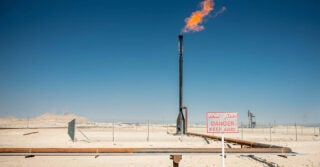- Resources
- National oil companies’ oversized and overlooked methane emissions, how finance and industry must help now
Resources
National oil companies’ oversized and overlooked methane emissions, how finance and industry must help now
Published: November 28, 2023 by Andrew Baxter
The UN climate talks hosted in Dubai this month will shine a bright light on the pivotal role national oil companies, like UAE’s Abu Dhabi National Company (ADNOC), can and ultimately must play in the fight against climate change – particularly the urgent need to reduce methane emissions from the oil and gas supply chain.
A recent report from UNEP and partners states that the world must decrease global oil and gas production and consumption by 18% by 2030. From 2020 to 2050, oil and gas must decrease by 67% and 54%, respectively. This implies a reduction in fossil fuel-related infrastructure, notably a halt in new exploration and early retirement of the most polluting fields. Dramatically reducing our use of oil and gas is of primary importance, yet the dogged persistence of hydrocarbons in the global energy mix necessitates a laser focus on reducing operational emissions now.
Even before fossil fuels are consumed, their production and distribution are major sources of greenhouse gas (GHG) emissions. Drilling, transporting and processing oil and gas generated more than five billion tons of CO₂-equivalent in 2022, according to the International Energy Agency (IEA). Cutting these emissions is a powerful opportunity to reduce the climate impact of fossil fuels that remain as countries and sectors work toward decarbonization.
This is especially true for methane, which has over 80 times the 20-year warming power of CO₂ – making it the fastest way to slow the rate of warming. International Energy Agency analysis consistently shows it’s also the simplest and most cost effective.
Until now, globally traded companies like Chevron, Shell and Exxon have been the industry’s most visible methane emitters. But these and all the other name-brand public companies together produce only 12% of global oil and gas. National oil companies (NOCs) produce more than half.
A crucial role
Among all energy companies, NOCs have some of the lowest development and production costs, and will likely be the ones lifting the last barrel from the ground. Addressing their operational emissions now is critical to bending the emissions curve as these nations take on the more challenging task of transitioning their economies away from fossil fuels.
It’s hard to characterize all NOCs together because they’re so varied; ADNOC in UAE is very different from Sonatrach in Algeria or Petrobras in Brazil. They each face unique challenges – and not all have equally deep pockets. But they share some important attributes.
NOCs are often their countries’ biggest economic engine. Decisions about production, trade and emission performance extend beyond the balance sheet to questions of politics, domestic finance and foreign affairs. Many have limited access to outside financing and technical resources required to achieve emission progress and, as a result, lag behind their publicly traded peers.
NOC Opportunities at COP28
In addition to broader discussions at COP 28, climate science makes the importance of NOCs undeniable. To hit international climate targets, NOC countries will have to reduce their oil and gas methane emissions to near zero levels by 2030, which means they must formalize their methane strategies now and begin reporting their emissions through UNEP’s Oil and Gas Methane Partnership. And they should commit to eliminating non-emergency flaring by 2030 – a feasible target that requires formal commitments now.
This is a significant challenge, and NOCs should not be asked to do it alone, especially those that operate in the global south. We’re hopeful they receive the support they require from the international community. Most of the publicly traded major oil and gas companies have been working on methane for years, accumulating valuable technical experience that should be channeled to NOCs.
Financing solutions
Likewise, many NOCs don’t have the financial resources to execute on their own. The IEA says NOCs in low and lower-middle income countries will need $12 billion in financing to achieve the 75% methane reduction we need. Between 2019 and 2020, less than $100 million of global capital flows went to oil and gas methane mitigation. That is just 0.01% of the more than $780 billion that flowed to new fossil fuel projects over the same period. To close this gap, banks and capital markets need to make funding methane abatement for NOCs a priority.
There are already tailored financial instrument options available to help companies achieve climate goals. The global climate community should explore vehicles like sustainability-linked lending, transition bonds, and project finance models to help low- and middle-income NOC countries identify and execute oil and gas methane reduction opportunities and incentivize them to commit to leading industry practice on target setting, transparent measurement standards, and reporting through OGMP 2.0.
The world simply cannot continue to use fossil fuels anywhere near current levels, and whatever one’s view of the trajectory of the energy transition, we can’t ignore the need for national oil companies to clean up their operations. COP28 presents a critical opportunity to elevate the significance of NOCs in our global effort to stabilize the climate and provide them with the support and assistance they will need to join the transition.
The UAE isn’t the first oil-rich nation to host a COP. But as one of the largest NOC nations, where the global east meets the global west and the global north meets the global south, it may be one of the most important.

